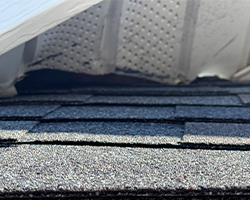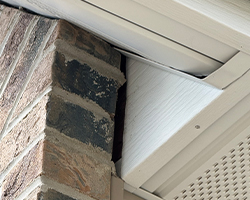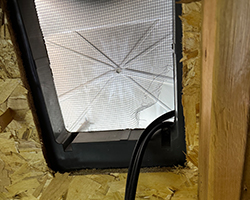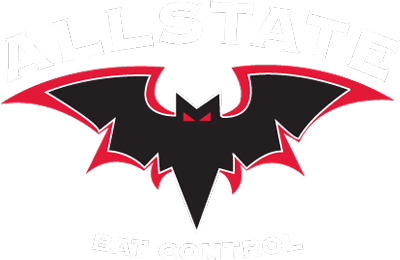Bat Proofing
Seal the Deal. Keep Bats Out for Good!
Bats are elusive creatures and masters at hiding! They prefer dark, humid caves or abandoned mines where they can hang upside down and stay protected from predators. Bats will slip into buildings, barns or attics through small gaps in the structures to find warm, sheltered hideaways.
Some bats can fit through gaps as small as 3/8 inch wide—the width of a pencil or drinking straw! They can squeeze into gaps in rooflines, soffits, or attic vents. They can enter your house through cracks in walls, chimneys or loose bricks as well as openings around windows, doors, or piping.
Bats also leave their excrements (Guano/poop and urine) where they live. If left unchecked, homeowners may encounter health risks, unpleasant odors, structural damage and other pests that may be attracted to these aftereffects.
Get Bats Out and Keep Them Out.
Our bat-proofing services come with a three-year guarantee. Rest assured, we'll work with you through every step to keep your home bat-free and secure.
Step 1
Estimate
We offer free estimates based on a phone conversation with the homeowner, the information shared, and photos of the home. Our estimates provide a great starting point to understand what we can do and how we do it.
Step 2
Onsite Inspection
Bat proofing requires a comprehensive onsite inspection of your home from the rooftop to the foundation, including the attic. Onsite inspections are free if the location is within a 30-mile radius of Alexandria, Minnesota. If the location is outside of our area, we charge for driving and inspection time. We waive this fee if you hire us.
Step 3
Bat Proofing
We seal structural gaps and install excluders that allow bats to exit without reentering. We use aesthetically pleasing bat-proofing methods that blend seamlessly with your home's exterior. Whether it's around vents, windows, or eaves, we will preserve the look of your property.
The following images show bat damage and construction issues that allow bats to enter your structure.




Fun Facts About Bats
You might have bats if you see them exiting your home at dusk, find droppings near entry points, or hear chirping and scratching, especially in winter. Bat guano has a distinct odor and differs from mouse droppings in size and texture.
We offer free estimates based on a phone conversation with a homeowner to understand their concerns, learn about the home, and view photos of the home. We do not charge for onsite inspections if the house is located within a 30-mile radius of Alexandria, Minnesota. If your home is located outside of our area, we charge for our driving time and our inspection time. We will waive this fee if you hire us.
What's included in it? We offer a three-year guarantee for our bat-proofing services.
Yes. But bat-proofing requires thorough inspection and proper placement of excluders. Bats can squeeze through tiny gaps, and sealing openings incorrectly may drive them into the interior of your home.
Yes. Bats in your home can cause serious issues. Bat guano and urine create strong odors, can spread disease, attract other pests, and damage structures. It is essential to remove them as soon as possible and bat-proof your home to stop bats from returning.
Yes. Bats control pests, aid in pollination, and contribute to medical research. They play a vital role in the ecosystem and face threats like white-nose disease – a fungal infection that affects hibernating bats – which is causing the death of millions of bats across North America.
Once a bat is lost or disoriented in a structure, they will look for a way out by following air drafts. Bats enter living spaces by following air drafts through attic hatches, utility openings, chimneys, or wall cavities. This often happens in late summer when young bats explore or during warm winter days when hibernating bats become active.
It's hard to know exactly, but bats live in colonies, so if you've seen one, there are likely more. With our professional inspection methods, we can provide an estimate of the colony size.
Common construction issues that allow bats to enter a building include:
- Gaps in soffits, fascia or eaves.
- Unsealed roof vents, ridge caps, or chimneys.
- Loose or missing siding and shingles.
- Opening around utility lines, plumbing or wiring.
- Cracks in brickwork or the foundation.
- Poorly sealed attic hatches or gaps in insulation.
- Unscreened gable vents or attic vents.
The costs to remove bats from your house will vary based on factors like house style, roof type, and accessibility. For an estimate, fill out our online form. You can also take multiple pictures of your home from different vantage points and text them to us. A simple look at your home's structure will give us an idea of what is needed to bat-proof it.

